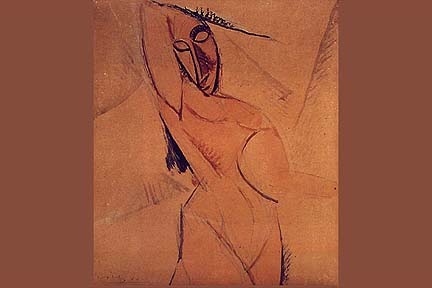This new movement arose out of the desire to represent and define the new modern reality that was surrounding the world during that time as well as a a reaction against the traditional ways of representing light and color (Cubism). In the textbook Megg's History of Graphic Design, it is said in the description of figure 13-1 of Picasso's Nude c. 1906-7 that "the seeds of cubism are contained in the fragmentation of the figure and background spaces into abstracted geometrical planes.
Marten Jansen states in his column titled "Pablo Picasso Cubism" that it is important to fully realize how important cubism is and that it is significant to note that cubism is not just the "style" of Pablo Picasso but it is the mark of the real beginning of abstract art which was a new wave of thinking and a new way of looking at art.
I would like to reflect on the fact that cubism "began a new artistic tradition and way of seeing that challenged the four-hundred-year Renaissance tradition of pictorial art" (Megg). The way that I interpret that statement made on page 256 of my textbook for this class Picasso and Braque essentially just broke all of the rules that were set forth for them prior to the beginning of their movement, and that they decided to make new rules for themselves and every artist after them.
Another statement from the textbook that I would like to reflect upon this week is one of the statements made on page 257 of Megg's History of Graphic Design. The statement is "Cubism has a strong relationship with the process of human vision. Our eyes shift and scan a subject: our minds combine these fragments into a whole." This can be connected to my interpretation of the definition of cubism changing and challenging the way art was viewed for hundreds of years due to the idea that now instead of the entirety of a subject being present in a work, now only fragments appear. The human mind is an incredible thing and it is capable of filling in the absent lines to complete the subject. This new way of thinking about art challenged the past due to the idea that now the viewer's mind has to work a bit more to really see what is being presented to them.
Examples of works where the viewer's mind has to be put to work:
Nude, c 1906-07 Pablo Picasso
Les Demoiselles d'Avignon, 1907, Pablo Picasso
The Dream, 1931, Pablo Picasso.
It was a way of, for lack of a better term, pissing on the past of what used to be accepted as art. Picasso forced the viewer's mind to find lines where there were not any, in his new movement of cubism. It is important to realize how incredible the human mind is, and Picasso's work during his cubist movement exemplifies this concept.
Works Cited:
Megg, Philip B. Megg's History of Graphic Design. 5th ed. Hoboken, New Jersey: John Wiley & Sons, Inc., 2012. Print.
Cubism: A New Vision." Web. 2 Feb 2014. http://www.mdc.edu/Wolfson/Academic/ArtsLetters/art_philosophy/Humanities/Cubism/cubism%20front2.htm
"Pablo Picasso. Biography" Web. 23 Feb 2014. http://www.biography.com/people/pablo-picasso-9440021
Jansen, Marten. "Pablo Picasso Cubism." Web. 23 Feb 2014. http://pablo-picasso.paintings.name



No comments:
Post a Comment